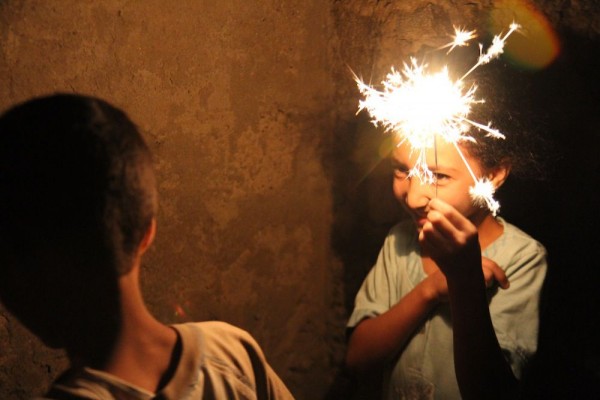Holiday celebrations in a Yemeni village defy the country’s reputation.
By Nafeesa Syeed
Near the Yemeni village of Hayfan, hamlets stretch from the base of a horseshoe-shaped valley up the mountain that forms the natural border between Hayfan and the other settlements in the neighboring valley far below. The mountains here are simultaneously lush, with terraced fields of emerald corn stalks, and dry and rocky, with desert brush and cacti. Rectangular brick homes featuring arched Yemeni stained-glass windows are built into the slopes. At the ends of the encircling summits—the edges of the horseshoe—are openings that yield to more valleys and peaks beyond. On the pavement of the main road out of town the inescapable slogan of the Arab Spring is scribbled again and again: Irhal, “Leave.”
Here, Eid, the festival marking the end of the holy month of Ramadan, is populated by pops, screams, sparks, rockets, and explosions. But these are not from the men in markets with rifles slung over their shoulders, nor the boys brandishing pistols on the rural roadside. They are not from Al Qaeda bombings or American drone strikes.
With the natural acoustics of the surrounding mountains, the hisses, cracks, and ear-drum-shattering booms echoed late into the night. Amid the cacophony, the laughter of children also carried.
In late August the denizens of Hayfan officially marked the holiday on a Sunday, but the Eid celebrations really took off Saturday night, after the final breaking of the fast. Following dusk prayers, kids flocked to corner shops to buy firecrackers and fireworks, and rounded up their stashes of matches and cigarette lighters. From the rooftops, girls waved sparklers and boys launched cylinders that spewed columns of light. Some pitched bottle rockets (minus the bottles), or lobbed grenade-like fireworks that blasted into colors as they hit the ground. The electricity, as it often does, shut down. Hatha Yemen, “This is Yemen,” is what locals say when this happens. Others let out a swear, or lay blame for the recurrent outages on figures such as former president Ali Abdullah Saleh, who was ejected in the country’s revolution.
Full-blown fireworks, the kind American towns use in Fourth of July festivities, splintered the darkness from every direction. They shot up and flowered into green and red and white fountains. Smoke wafted in the cool air. In the valleys beneath, combustibles glowed—red and yellow orbs. With the natural acoustics of the surrounding mountains, the hisses, cracks, and ear-drum-shattering booms echoed late into the night. Amid the cacophony, the laughter of children also carried.
With the sky alight, the blackout could not stop revelers from engaging in other traditions. Inside one home, a woman strapped a wide orange flashlight to her head to illuminate the hands and arms of young girls while she applied henna in floral and geometric designs. Solid patches of the brown dye caked their fingertips.
Boys in collared shirts and girls in frilly frocks towed plastic bags from door to door, as though trick-or-treating, to the homes of relatives and neighbors.
Early Sunday morning the takbirat, a worshipful Arabic chant repeated on Eid day, streamed from loudspeakers. Men dressed in white robes moseyed to prayer services. Belts embroidered in gold and silver kept their J-shaped daggers snug against their bellies. Imams thundered their sermons over microphones from mosques at opposite sides of the valleys. On the inclined paths of Hayfan, women and men greeted one another by first gripping fists, then kissing the back of the right hand. For the first time in a month, with the regimen of the fast behind them, they could sip tea and chew qat leaves, a prevalent narcotic, during daylight hours. Meanwhile, boys in collared shirts and girls in frilly frocks towed plastic bags from door to door, as though trick-or-treating, to the homes of relatives and neighbors. They collected toffee and chocolate and Yemeni rials printed with images of the country’s historic landmarks. Some children huddled, their sacks outstretched to compare their loot.
Soon enough, the sound of firecrackers pierced the midday calm. Though they were barely visible under the imposing sun, pyrotechnics flashed and roared again from lofty points. The bangs persisted into that night and the next day. For long stints, the power again failed. But the sparks continued to erupt.
Nafeesa Syeed is a freelance writer and editor based in Washington. She is currently co-writing a book on Arab women entrepreneurs. You can follow her @NafeesaSyeed.
Musa Syeed is a New York-based filmmaker. His debut feature film, Valley of Saints, won the 2012 Sundance Film Festival audience award. He is developing a film project in Yemen. You can follow him on Twitter @musasyeed.
